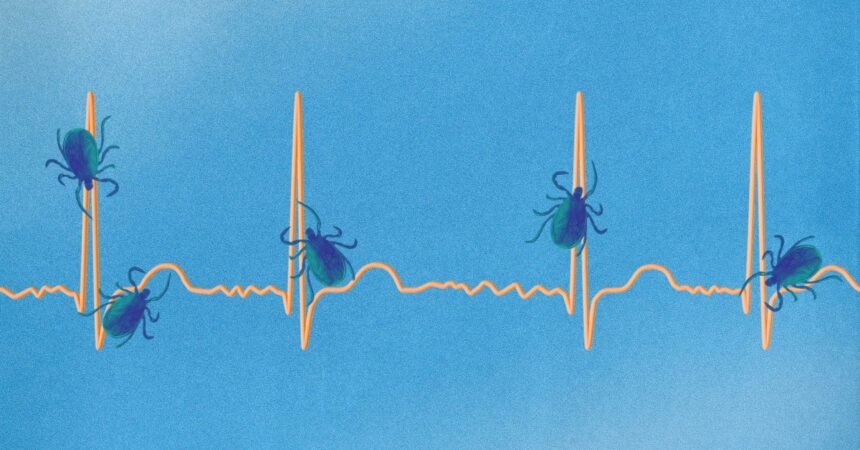Nearly 500,000 people are diagnosed with Lyme disease each year in the U.S. For about 75% of them, the first sign will be a skin lesion that appears one to four weeks after being bitten by an infected deer tick. But it might not look how you’d imagine: Only 20% of these lesions take on the classic bull’s-eye appearance commonly associated with Lyme.
Other early symptoms of Lyme disease mimic what you might experience with the flu: a fever, chills, muscle aches, and swollen lymph nodes. Within the first five to 10 days of Lyme disease infection, most people will only experience these relatively ordinary symptoms. If they’re promptly diagnosed with and treated for Lyme—which generally means two to three weeks of the antibiotic doxycycline—the story often ends there.
But for up to 10% of people, most of whom aren’t diagnosed or treated promptly, the disease triggers lingering, serious symptoms. Researchers aren’t sure exactly what causes chronic Lyme disease, but speculate it could be the result of factors like persistent bacteria or genetic predispositions. When someone has it, “there’s almost nothing it can’t do,” says Dr. Amy Edwards, an assistant professor of pediatrics at the Case Western Reserve University School of Medicine who specializes in infectious diseases. The complex symptoms often stump doctors, but “once it’s caught you off guard a few times, you’re kind of looking for it everywhere. Every time someone comes in with weird symptoms in the summer, you’re like, ‘Could it be Lyme disease?’”
Here’s a look at some of the surprising symptoms that Lyme disease can cause, especially as it progresses.
Heart problems
When Lyme isn’t treated effectively early on, it can end up impacting the cardiac, neurologic, and rheumatologic systems, says Dr. Amy Duckro, an infectious disease specialist with Kaiser Permanente in Colorado. In 1 out of every 100 patients, for example, Lyme bacteria enters the heart tissues, which is called Lyme carditis. This kind of heart inflammation can lead to light-headedness, fainting, shortness of breath, heart palpitations, or chest pain.
Read More: The Best and Worst Way to Remove a Tick
In some cases, people develop atrioventricular block, which is a blockage that prevents electrical signals from moving from the upper to the lower chambers of the heart. When the blockage gets particularly bad, patients often need a temporary pacemaker paired with IV antibiotics, says Dr. Sunjya K. Schweig, who’s on the scientific advisory board of the Bay Area Lyme Foundation, a non-profit that aims to accelerate medical breakthroughs for Lyme disease. He wants people to be aware that this can happen, and to take symptoms like new heart palpitations seriously. “It’s treatable, it’s curable, and it can also kill you if it’s not caught,” he says. “It’s a really big deal.”
Brain fog
It took Kirsten Stein more than two years—and 15 doctor’s appointments—to be diagnosed with Lyme disease. During that time, she struggled with an array of mental and physical symptoms. The most alarming was the brain fog and short-term memory loss that clouded her every day: She recalls running into a close friend, for example, and not being able to summon the names of the woman’s kids, despite seeing them multiple times a week. “I remember thinking, ‘That’s not good,’” she says. During a conversation with her husband, she couldn’t conjure the word “glass” and started pointing at things; while playing a game with friends, she excused herself to the restroom because she couldn’t think clearly enough to participate. Another time, she dropped her son off at school—and five minutes later, asked her daughter where he was. “It was terrifying,” she says.
Read More: Long Dismissed, Chronic Lyme Disease Is Finally Getting Its Moment
Many patients report similar experiences with brain fog, Schweig says. It’s likely caused by Lyme-induced inflammation in the central nervous system. “We see a huge amount of brain effects: difficulty focusing, difficulty thinking, difficulty reading and absorbing information,” he says. “It can be extremely disruptive to people’s lives, because they can’t function. They can’t go about their normal learning and working and paying attention and doing projects and following through with their tasks.”
Bell’s palsy
There are 12 nerves—called the cranial nerves—that originate in the brain and play an important role in sense and movement for different parts of the head, face, neck, and torso. Lyme disease can affect those nerves, triggering Bell’s palsy, which causes sudden weakness or paralysis on one side of the face. It’s especially common in adults, she says, and typically appears several weeks to months after infection.
Eye problems
In the early stages of Lyme disease, people sometimes experience eye irritation and conjunctivitis. As the condition progresses, “you can get cranial nerve inflammation or infections, and this can cause double vision called diplopia,” Schweig says. Research suggests Lyme can cause sudden vision loss, damage to the optic nerve, and neurotrophic keratitis (decreased corneal sensation). It’s also possible to experience blurry vision, eye floaters, tearing, extreme sensitivity to light, and inflammation of the retina.
Hearing problems
The inflammation that Lyme causes can affect the inner ear, leading to a variety of symptoms, including hearing loss and tinnitus, or ringing in the ears, Schweig says. Ear issues can also trigger dizziness and balance problems.
Read More: Scientists Have Identified the Lyme Disease Genes Responsible for Severe Symptoms
In one study that included 216 people with a tickborne disease, 162 experienced otolaryngological symptoms—making them a “frequent manifestation,” according to the study authors. The most common complaint was tinnitus (77% of participants), followed by vertigo and dizziness (54%), a headache (39%), and unilateral sensorineural hearing loss, or hearing loss in one ear (17%).
Arthritis
One of the most common symptoms of Lyme that Edwards sees in young people is arthritis. It often happens the same way: Kids show up in the emergency room in the late fall with a big, swollen knee and, perhaps, a low-grade fever. Sometimes they also have a limp or are unable to put weight on their leg. “It’s actually not crazy painful—it hurts, but it’s not debilitating,” she says. “Everybody’s like, ‘Did you injure it?’” But it turns out they’re experiencing arthritis caused by a tick bite they might not have even been aware of during the summer. “It’s actually the most common way that Lyme presents in children,” Edwards says. Kids typically get better once they start a four-week regimen of doxycycline. The problem, she adds, is that not all clinicians make the connection, which can delay diagnosis and proper treatment.
Debilitating fatigue
Research suggests that Lyme disease can cause persistent fatigue, even when it’s diagnosed and treated early. In one study, participants with a history of Lyme were 8 to 15 times more likely to report moderate or severe fatigue than those who had never had the disease.
That resonates with Caitlin Durcan, 27, who developed Lyme disease after being bitten by a tick while working at a summer camp in upstate New York. She experienced a range of symptoms—migraines, puberty-like emotional instability, brain fog, puffy eyes—for months before finding a doctor who prescribed an aggressive treatment regimen that has mostly alleviated her symptoms. At the time, Durcan was in college, and one of the worst manifestations of the disease was overwhelming fatigue. “I was very sluggish and tired all the time,” she recalls. “I’d go to class, I’d come home, and I’d sleep for three hours. I’d wake up, I’d go to my classes, and I’d come back home and sleep. I couldn’t stay awake for a day, and my friends were just like, ‘Clearly something is really wrong.’”
Durcan—who never developed more traditional symptoms like a rash or fever—says her experience recovering from Lyme changed her entire perspective on life. She was so relieved to feel like herself again that she started venturing outside her comfort zone, seizing social opportunities and signing up for her first-ever half marathon. She urges other people struggling with Lyme-related symptoms to continue advocating for themselves. “It’s a really tricky, weird illness, and it presents itself so differently in everyone” she says. “Finding a doctor who believes you and understands that what you’re telling them is the truth, and who wants to help you, is huge.”







